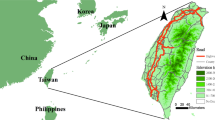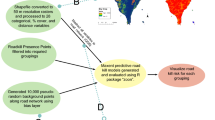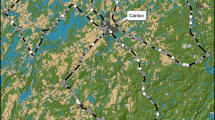Abstract
Road fatalities are among the major causes of mortality for Strigiformes species and may affect the population’s survival. The use of mitigation strategies must be considered to overcome this problem. However, because mitigation along the total length of all roads is not financially feasible, the locations where Strigiformes roadkills are more frequent (i.e., road fatality hotspots) must be identified. In addition to hotspot identification, factors that influence the occurrence of such fatalities should be recognized to allow mitigation measures to be delineated. We used road fatality data collected from 311 km of southern Portugal roads over a 2-year period to compare the performance of five hotspot identification methods: binary logistic regression (BLR), ecological niche factor analysis (ENFA), Kernel density estimation, nearest neighbor hierarchical clustering (NNHC), and Malo’s method. BLR and ENFA modelling were also used for recognizing roadkill deterministic factors. Our results suggest that Malo’s method should be preferred for hotspot identification. The main factors driving owl roadkillings are those associated with good habitat conditions for species occurrence and specific conditions that promote hunting behavior near roads. Based on these factors, several mitigation measures are recommended.





Similar content being viewed by others
References
Andrews A (1990) Fragmentation of habitats by roads and utility corridors: a review. Aust Zool 26:130–141
Árias JM (1994) Nota sobre alimentacion de Mochuelo (Athene noctua L., Aves: Strigiformes). Acta Vertebr 21:183–185
Augustin NH, Mugglestone MA, Buckland ST (1998) The role of simulation in spatially correlated data. Environmetrics 9:175–196
Baudvin H, Genot JC, Muller Y (1991) Les rapaces nocturnes. Sang de la Terre, Paris
Bourquin JD (1983) Mortalité des rapaces le long de l’autoroute Géneve-Lausane. Nos Oiseaux 37:149–169
Cabral MJ, Queiroz AI, Palmeirim J, Almeida J, Rogado L, Santos-Reis M, Oliveira ME, de Almeida PR, Dellinger T (2005) Livro vermelho dos vertebrados de Portugal. Assírio & Alvim, Lisboa
Clevenger AP, Churszcz B, Gunson KE (2003) Spatial patterns and factors influencing small vertebrate fauna road-kill aggregations. Biol Conserv 109:15–26
Cramp S (1992) Handbook of the birds of Europe, the Middle East and North Africa—the birds of the western Paleartic. Oxford University Press, Oxford
de Bruijn O (1994) Population ecology and conservation of the barn owl Tyto alba in farmland habitats in Liermers and Achterhoek (The Netherlands). Ardea 82:1–109
Del Hoyo J, Elliot A, Sargatal J (1999) Barn-owls to hummingbirds. Lynx, Barcelona
Elias GI, Reino LM, Silva T, Tomé R, Geraldes P (1998) Atlas das aves invernantes do Baixo Alentejo. Sociedade Portuguesa para o Estudo das Aves, Lisboa
ESRI (2004) ArcGIS 9. Environmental Systems Research Institute, New York
Everett B (1974) Cluster analysis. Heinemann Educational, London
Exo KM (1992) Population ecology of little owls Athene noctua in Central Europe: a review. In: Galabraith CA, Taylor I, Percival S (eds) The ecology and conservation of European owls. Joint Nature Conservation Committee, Peterborough, pp 64–75
Fahrig L, Pedlar JH, Pope SE, Taylor PD, Wegner JF (1995) Effect of road traffic on amphibian density. Biol Conserv 73:177–182
Fajardo I (2001) Monitoring non-natural mortality in the barn owl (Tyto alba), as an indicator of land use and social awareness in Spain. Biol Conserv 97:143–149
Fajardo I, Pividal V (1994) Alarmante regresión de la lechuza común en la comunidad de Madrid. Quercus 97:34
Fajardo I, Vázquez, Martín F, Calvo J, Ibañez F, Jiménez M (1992) Informe de los atropellos en las rapaces nocturnas. In: López J (ed) I Jornadas para el estudio y la prevención de la mortalidad de vertebrados en carreteras. CODA, Madrid
Fajardo I, Pividal V, Trigo M, Jiménez M (1998) Habitat selection, activity peaks and strategies to avoid road mortality by the little owl Athene noctua. Alauda 66:49–60
Fajardo I, Babiloni G, Miranda Y (2000) Rehabilitated and wild barn owls (Tyto alba): dispersal, life expectancy and mortality in Spain. Biol Conserv 94:287–295
Field A (2000) Discovering statistics using SPSS for Windows. Sage, London
Finder RA, Roseberry JL, Woolf A (1999) Site and landscape conditions at white-tailed deer-vehicle collision locations in Illinois. Landsc Urban Plan 44:77–85
Forman RT, Alexander LE (1998) Roads and their major ecological effects. Annu Rev Ecol Syst 29:207–231
Forman RTT, Sperling D, Bissonette J, Clevenger AP, Cutshall CD, Dale VH, Fahrig L, France R, Goldman C, Heanue K, Jones JA, Swanson FJ, Turrentine T, Winter TC (2003) Road ecology: science and solutions. Island Press, Washington
Frías O (1999) Estacionalidad de los atropellos de aves en el centro de España: numero y edad de los individuos y riqueza y diversidad de especies. Ardeola 46:23–30
Gattrell AC, Bailey TC, Diggle PJ, Rowlingsont BS (1996) Spatial point pattern analysis and its application in geographical epidemiology. Trans Inst Br Geogr 21:256–274
Geneletti D (2003) Biodiversity impact assessment of roads: an approach based on ecosystem rarity. Environmental Impact Assessment Review 23:343–365
Gitman I, Levine MD (1970) An algorithm for detecting unimodal fuzzy sets and its application as a clustering technique. IEEE Trans Comput C-19:583–593
Gragera F, Corbacho MA, Deavalos J (1992) La repercusión del tráfico en carreteras sobre las rapaces. In: López J (ed) I Jornadas para el estudio y la prevención de la mortalidad de vertebrados en carreteras. CODA, Madrid
Guisan A, Zimmermann N (2000) Predictive habitat distribution models in ecology. Ecol Model 145:111–121
Hammond R, McCullagh P (1978) Quantitative techniques in geography: an introduction. Clarendon Press, Oxford
Hels T, Buchwald E (2001) The effect of road kills on amphibian populations. Biol Conserv 99:331–340
Hernandez M (1988) Road mortality of the little owl (Athene noctua) in Spain. J Raptor Res 22:81–84
Hirzel A (2004) Biomapper 3 user’s manual. Biomapper, Lausanne
Hirzel A, Arlettaz R (2004) Modelling habitat suitability for complex species distributions by environmental-distance geometric mean. Environ Manage 32:614–623
Hirzel A, Hausser J, Chessel D, Perrin N (2002a) Ecological-niche factor analysis: how to compute habitat-suitability maps without absence data? Ecology 83:2027–2036
Hirzel A, Hausser J, Perrin N (2002b) Biomapper 3.1. Laboratory for Conservation Biology. Biomapper, Lausanne
Hodson NL (1962) Some notes on the causes of bird road casualities. Bird Study 9:168–172
Hosmer D, Lemeshow S (2000) Applied logistic regression. John Wiley & Sons, New York
IGP (1990) Cartas de ocupação de solo. Instituto Geográfico Português, Lisboa
Knapp RA, Matthews KR, Preisler HK, Jellison R (2003) Developing probablistic models to predict amphibian site occupancy in a patchy landscape. Ecol Appl 13:1069–1082
Levine N (2004a) CrimeStat III: a spatial statistics program for the analysis of crime incident locations. National Institute of Justice, Washington DC
Levine N (2004b) Manual of CrimeStat III. National Institute of Justice, Washington DC
Lodé T (2000) Effect of a motorway on mortality and isolation of wildlife populations. Ambio 29:165–168
Lourenço RF, Basto MP, Cangarato R, Álvaro MC, Oliveira VA, Coelho S, Pais MC (2002) The owl (order Strigiformes) assemblage in the north-eastern Algarve. Airo 12:25–33
Lourenço R, Abelho B, Pedroso N, Santos E (2004) Introdução ao estudo das aves de rapina. CEAI, Évora
Malo JE, Suarez F, Diez A (2004) Can we mitigate animal-vehicle accidents using predictive models? J Appl Ecol 41:701–710
Manel S, Williams HC, Ormerod SJ (2001) Evaluating presence-absence models in ecology: the need to account for prevalence. J Appl Ecol 38:921–931
Marques JM (1994) Vertebrados Mortos Por Atropelamento (EN 118 Alcochete/Porto-Alto). In: Seminário sobre a avaliação do impacte ambiental de projectos rodoviários, Espinho
Massemin S, Maho Y, Handrich Y (1998) Seasonal pattern in age, sex and body condition of barn owls Tyto alba killed on motorways. Ibis 140:70–75
Massemin S, Zorn T (1998) Highway mortality of barn owls in northeastern France. J Raptor Res 32:229–232
Meek WR, Burman PJ, Nowakowski M, Sparks TH, Burman NJ (2003) Barn owl release in lowland southern England-a twenty-one year study. Biol Conserv 109:271–282
Menard S (1995) Applied logistic regression analysis. Sage, Thousand Oaks, CA
Meunier FD, Verheyden C, Jouventin P (2000) Use of roadsides by diurnal raptors in agricultural landscapes. Biol Conserv 92:291–298
Mikkola H (1983) Owls of Europe. Poyser, London
Muntaner J, Mayol J (1996) Biología y conservación de las rapaces mediterráneas, 1994. SEO, Madrid
Newton I, Wyllie I, Asher A (1991) Mortality causes in British barn owls Tyto alba, with a discussion of aldrin-dieldrin poisoning. Ibis 133:162–169
Newton I, Wyllie I, Dale L (1997) Mortality causes in British barn owls (Tyto alba), based on 1,101 carcasses examined during 1963–1996. Biol Conserv Owls North Hemisph 190:299–307
Nielsen CK, Anderson RG, Grund MD (2003) Landscape influences on deer-vehicle accident areas in an urban environment. J Wildl Manag 67:46–51
Okabe A, Yamada I (2001) The K-function method on a network and its computational implementation. Geogr Anal 33:271–290
Okabe A, Okunuki K, Funamoto S (2003) SANET: a toolbox for spatial analysis on a network. Centre for Spatial Information Science, University of Tokyo, Tokyo
Pereira CD (1996) Regressão logística – obtenção de um modelo para o diagnóstico de asma. Dissertação do Mestrado em Probabilidades e Estatística, Faculdade de Ciências da Universidade de Lisboa, Lisboa
Petty SJ (1989) Productivity and density of tawny owls Strix aluco in relation to the structure of a spruce forest in Britain. Ann Zool Fenn 26:227–233
Pita R, Mira A, Beja P (2006) Conserving the Cabrera vole, Microtus cabrerae, in intensively used Mediterranean landscapes. Agric Ecosystems Environ 115:1–5
Ramp D, Caldwell J, Kathryn AE, Warton D, Croft DB (2005) Modelling of wildlife fatality hotspots along the Snowy Moutain Highway in New South Wales, Australia. Biol Conserv 126:474–490
Ramsden DJ (2003) Barn owls and major roads: results and recommendations. The Barn Owl Trust, Ashburton
Rivas-Martínez S (1981) Les étages bioclimatiques de la végétacion de la Peninsule Iberique. An Jard Bot Madr 37:251–268
Saeki M, Macdonald DW (2004) The effects of traffic on the raccoon dog (Nyctereutes procyonoides viverrinus) and other mammals in Japan. Biol Conserv 118:559–571
Santos SM, Simões P, Mathias ML, Mira A (2006) Vegetation analysis in colonies of an endangered rodent, the Cabrera vole (Microtus cabrerae), in southern Portugal. Ecol Res 21:197–207
Seiler A (2001) Ecological effects of roads. A review. Grimsö Wildlife Research Station, Dept. of Conservation Biology, University of Agricultural Sciences, Riddarhyttan
Shawyer CR (1987) The barn owl in the British Isles. Its past, present and future. The Hawk Trust, London
Sokal R, Rohlf F (1995) Biometry—the principles and practice of statistics in biological research. Freeman, New York
SPSS (2004) SPSS statistical software 13.0 for Windows. SPSS, Chicago
Tabachnik BG, Fidell LS (1996) Using multivariate statistics. Harper Collins, New York
Taylor I (1994) Barn owls: predatory-prey relationships and conservation. Cambridge University Press, Cambridge
Tomé R, Bloise C, Korpimäki E (2004) Nest-site selection and nesting success of little owls (Athene noctua) in Mediterranean woodland and open habitats. J Raptor Res 38:35–46
Tucker GM, Heath MF, Tomialojc L, Grimmett RF (1994) Birds in Europe. Their conservation status. Bird Life International, Cambridge
Van Der Reest PJ (1992) Kleine zoogdieren in nederlanse wagbermen: oecologie en beheer. Lutra 35:1–27
Acknowledgements
We thank Rui Lourenço and Frederico Mestre for help solving some issues in this study. This work was supported through a master scholarship from Fundação Eugénio de Almeida to Luis Gomes.
Author information
Authors and Affiliations
Corresponding author
About this article
Cite this article
Gomes, L., Grilo, C., Silva, C. et al. Identification methods and deterministic factors of owl roadkill hotspot locations in Mediterranean landscapes. Ecol Res 24, 355–370 (2009). https://doi.org/10.1007/s11284-008-0515-z
Received:
Accepted:
Published:
Issue Date:
DOI: https://doi.org/10.1007/s11284-008-0515-z




